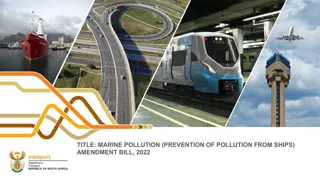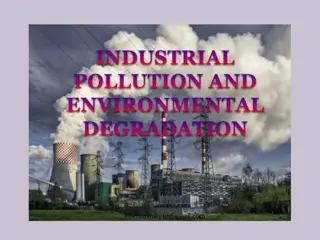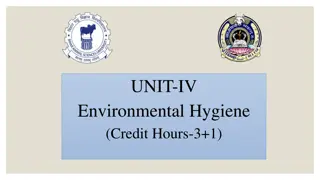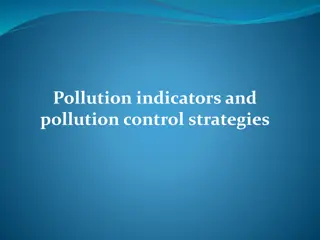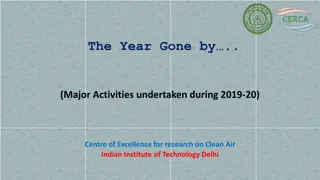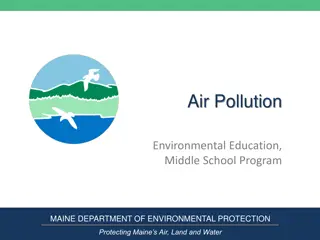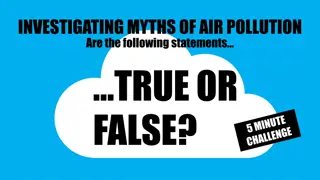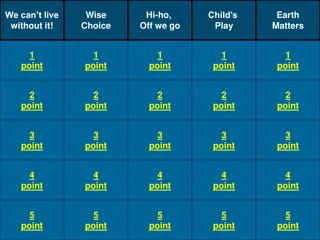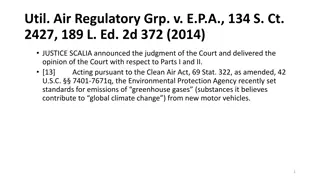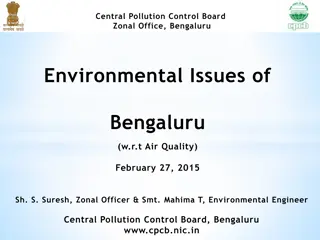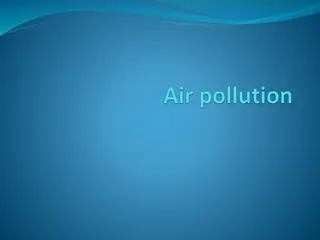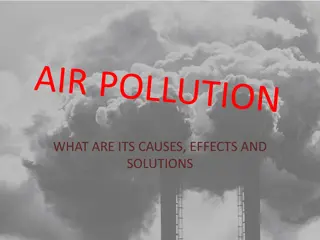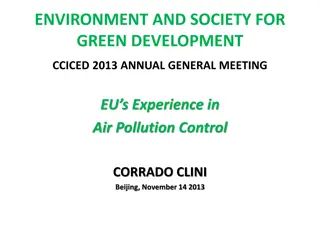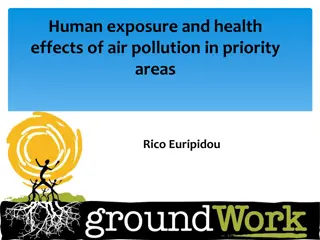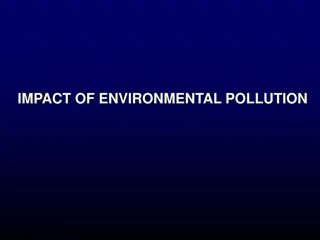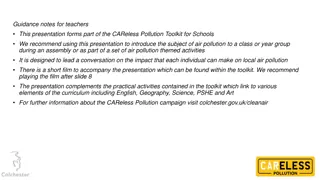2023 Clean Air KNUST Summer School on Air Quality and Pollution Prevention
Explore the importance of standards in environmental quality, focusing on Ghana's regulations and EPA's mandate. Learn about the processes involved in setting standards for air quality and vehicle emissions, emphasizing the role of standards in protecting the environment and public health.
Download Presentation

Please find below an Image/Link to download the presentation.
The content on the website is provided AS IS for your information and personal use only. It may not be sold, licensed, or shared on other websites without obtaining consent from the author.If you encounter any issues during the download, it is possible that the publisher has removed the file from their server.
You are allowed to download the files provided on this website for personal or commercial use, subject to the condition that they are used lawfully. All files are the property of their respective owners.
The content on the website is provided AS IS for your information and personal use only. It may not be sold, licensed, or shared on other websites without obtaining consent from the author.
E N D
Presentation Transcript
2023 CLEAN AIR-KNUST SUMMER SCHOOL ON AIR QUALITY AND POLLUTION PREVENTION 2ND NOVEMBER 2023 CLEAN AIR -KNUST SUMMER PRESENTER: EMMANUEL K-E APPOH SCHOOL: (MANAGING CONSULTANT/ASSIST. FACILITY MANAGER OF AFRI-SET/FACILITATOR) AIR POLLUTION AND EMISSIONS STANDARD AND VENUE: KNUST, KUMASI DATE: 30TH OCTOBER 2023 REGULATIONS IN GHANA
Presentation Outline What are Standards and their importance? EPA S Mandate & Local Government Why are Standards set? Processes involved in setting the Ghana Standards for Environmental Quality The Ghana Air quality and Vehicle Emission Standards conclusion
What is a Standard & why are they Important? Standards are published documents that establish specifications and procedures designed to ensure the reliability of the materials, products, methods, and/or services people use every day. Standards address a range of issues, including but not limited to various protocols that help ensure product functionality and compatibility, facilitate interoperability and support consumer safety and public health. Standards make it easier to understand and compare competing products. As standards are globally adopted and applied in many markets, they also fuel international trade. Application of standards brings about the credibility of new products and new markets can be verified. They are useful for fuelling the development and implementation of technologies that influence and transform the way we live, work and communicate. They are maximum threshold limits for parameters, that are set to protect the environment and public health
EPAS Mandate Constitution of Ghana Article 36(9) of Ghana s Constitution requires: the State to take appropriate measures to safeguard the national environment for posterity. Article 41(K) enjoins every citizen to protect and safeguard the environment. - EPA Act 1994, Act 490, Agency mandated to oversee, coordinate and regulate all issues regarding the environment in Ghana and with a mission to co-manage, protect and enhance the country s environment, in particular, as well as seek common solutions to global environmental problems. The mission is to be achieved by implementing 17 functions set out in Part 1 Section 2 of the Act. Two key functions of the Agency involve in environmental quality management include: (i) Development of a comprehensive environmental quality database to guide policy formulation and implementation, and (ii) Prescription of guidelines, standards and regulations relating to the pollution of air, water, land and any other forms of environmental pollution including the discharge of waste and the control of toxic substances.
EPAS Mandate (11) EPA first developed air and effluent (wastewater) quality and noise guidelines in 2000 and applied them till January 2019 when they were replaced by standards. Other Legal Drivers for Environmental management: EAR 1999 LI1652, Hazardous & Electronic waste control & management Act 2016, Act 917 and Regulations LI2250; Environmental Policy, Sustainable Development Goals 3,11 Target 3.9: substantially reduce the number of deaths and illnesses from hazardous chemicals and air, water and soil pollution and contamination Goal 11: Make cities and human settlements inclusive, safe, resilient and sustainable Target 11.6: reduce the adverse per capita environmental impact of cities, including by paying special attention to air quality and municipal and other waste management. Indicator 11.6.2: Annual mean levels of fine particulate matter (e.g. PM2.5 and PM10) in cities (population weighted). Etc.
Why the need for Environmental Quality Standards Need to protect the environment and public health from Air, Motor Vehicle Emissions, Effluent and Noise pollution. 91% of the world s population lives in places where air quality exceeds WHO guideline limit. The air we breath contains toxins that causes premature deaths, due to ischaemic heart disease, stroke, chronic obstructive pulmonary disease, lower respiratory tract infections and lung cancer, and rank among the top ten leading causes of death in the world. I million Africans die of preventable exposure to poor air 400,000 African children under five died prematurely because of the bad air they breathed (NATURE Journal| https://qz.com/africa/1316625 ). Estimated economic cost of these deaths in 2013 ($215 billion from outdoor pollution and $232 billion from indoor pollution) is greater than that caused by unsafe water, malnutrition (https://qz.com/africa/1316625/ and Rana Roy, 2016). Ghana; 2.5Bn eqv 4.2% of GDP VOL 559|12 JULY 2018; and unsafe sanitation
Burden of Disease- Contn In Ghana, Lower Respiratory infection ranked 2nd to malaria among top10 diseases and 3,000 deaths of children under 5yrs died from exposure to Household Air Pollution (GSS 2010) 28,000 people died in Ghana due to air pollution according to WHO estimate (WHO, 2017) 2,800 lives were lost in GAMA due to the effects of air pollution. This number is projected to increase to approximately 4,600 by 2030 if no action is taken to reduce current and projected future levels of air pollution. Implementing this air quality management plan, can reduce that number by 430 each year (EPA, 2015 Pollution from water, air and land is the largest environmental cause of disease and death in the world today, responsible for an estimated 9 million premature deaths in 2015.1Water pollution caused 1.8 million deaths in 2015 92% of all pollution-related mortality is seen in low-income and middle-income countries (Lancet. 2017; (published online Oct 19.) http://dx.doi.org/10.1016/S0140-6736(17)32345- 0
Technical Guidance Used to Derive the Environmental Quality Standards Use EPA Environmental Quality Guidelines derived in 2000 as the bases for the Standard development Studies/monitoring and research Committee comprising of relevant stakeholders formed Data collection/gathering ( both in-house and external) Data integrity verifications and validation significant risk posed by the parameters through indirect/direct toxicity in the ecosystem
Standard Processes- Contn Comparison with standards with other international standards (especially with that of developing countries with similar geographical conditions) Where no Ghana guidelines/standard exist, adoption of international standards were considered. National stakeholder workshop organized to review the draft standards National Technical review committee (NTC) formed and hosted by GSA to review the draft standards Draft standards from (NTC) sent back to selected independent experts for review Comments reviewed by NTC and incorporated into the Draft Standards, finalized and published
The Ghana Environmental Quality Standards Ghana Standard for Environment and Health Protection Requirements for Ambient Air Quality and Point Source/Stack Emissions (GS 1236, 2019) Ghana Standard for Environment and Health protection Requirements for motor vehicle emissions (GS 1219, 2018) Ghana Standard for Environment and Health Protection Requirements for Effluent Discharge (GS 1212, 2019) Ghana Standard for Health Protection Requirements for Ambient Noise Control (GS 1222, 2018) Ghana Standards for Acoustics - Guide for Measurement of Outdoor A-Weighted Sound Levels (GS 1253, 2018)
Ghana Standard for Environment and Health protection-Requirements for Ambient Air Quality and Point Source/Stack Emissions Standards (GS 1236, 2019) Ghana recognizes the need to reduce air pollution from stationary, aerial, mobile and non-point sources to levels which minimize harmful effects on public health, paying particular attention to sensitive populations such as the elderly, children and pregnant women, and the environment. This Ghana standard specifies the requirements and test methods ambient air quality point source or stack emissions based on the sources of energy
Requirements for point source/stack emissions The maximum limits for the corresponding pollutant are based on source of fuel/type of energy used Solid fuels eg. Biomass, Coal, fire wood Liquid Fuels eg. diesel, RFO, Ethanol, Bio-fuel Gaseous fuels eg. LPG, CNG Electrical energy eg. induction/electric arc furnaces, dryers, oven, kilns, Alumina & iron smelting among others Incinerators
Typical pollutants and text methods # POLLUTANTS MAXIMUM LIMITS TEST METHOD 1. Solid Fuels a. Sulphur Dioxide (mg/Nm3 )* 200 USEPA Method 6C b. Oxides of Nitrogen (mg/Nm3 ) 200 ISO 10849 c. Particulate Matter (mg/m3 ) 50 ISO 9096 2. Liquid Fuels a. Sulphur Dioxide (mg/Nm3 )* 500 USEPA Method 6C b. Oxides of Nitrogen (mg/Nm3 ) 400 ISO 10849 c. Particulate Matter (mg/m3 ) 50 ISO 9096 Electrical energy and Incinerators Other parameters: Note:1) Electrical Energy usage include induction/electric arc furnaces, dryers, oven, kilns, Alumina & iron smelting among others. * N represents Normal atmosphere and pressure CO, Hcl, HF, Mercury and mercury cpds, particulate lead
Requirements for Ambient Air quality & Fenceline AQ Sets obligations for EPA to Monitor 8 key ambient pollutants to establish trends in ambient air quality for policy formulation Sulphur Dioxide, Nitrogen Dioxide, PM10, PM2.5, Total Suspended Particulate matter, Black Carbon, Benzene and Lead Sets obligations for Industries among others to Monitor ambient pollutants along the periphery/fence-line of their facilities Parameters include PM10, PM2.5, Total Suspended Particulate matter, SO2, NO2, CO, O3, Hydrogen Sulphide, Hydrogen Cyanide, HCl, VOCs (BTEX) Metals (Cd, Pb, Hg, Chromium, Mn, Arsenic, Nickle) and organics (Dichloromethane, Trichloroethane, PAH, Dioxins/Furans, Total PCBs) The number of parameters to be monitored depend on the type of industry & emission characteristics
Requirements for AAQ and Point Source Emissions- Contn Equipment used for measurement of all pollutants shall be approved by the regulator. Test methods prescribed in this Ghana Standard or any equivalent International Standard test methods or other standard measuring instruments as shall be approved by the regulator for air quality monitoring An Owner or Operator of any premises shall provide the regulator or any other officer duly authorized by the regulator every reasonable assistance or facility available at the premises that the officer may require for the purpose of taking an action required to be undertaken under this standard in respect of the premises. Records of Fenceline air quality and point source emissions monitoring shall be kept (5 yrs) by undertakings and made available to the regulator upon request An undertaking shall be deemed to have complied with the requirements of this standard if after measurement and monitoring, the results show that emission does not exceed limits prescribed in this Ghana Standard
Motor vehicle emissions Standard (GS 1219, 2018) The Motor Vehicle Emission Standard is meant to ensure clean air and protect the environment and public health Vehicles emissions are affected by driving patterns, the vehicle type and age, fuel type and quality, road conditions, axel load, traffic speed and congestion, etc., as well as altitude and other ambient conditions. This Ghana Standard specifies the requirements for exhaust emissions of motor vehicles as well as tractors, farm equipment (such as combine harvester, etc.), mobile industrial / construction machines (such as excavators). The Ghana Standard has been set so as not to put too many vehicles off the road on introducing motor vehicle emission requirements in the country.
Motor Vehicle Emission Standard- Contn This first Ghana vehicle emissions standard is derived from the EURO II vehicle exhaust emission standard with some modifications to reflect local data collected by the Ghana Environmental Protection Agency (EPA) and research institutions. This Ghana Standard shall be reviewed on regular basis to meet best international practice The standard has been classified under two categories by vehicle year of manufacture and technology (vehicles manufactured before 1995 and those after 1995)
Emission requirements for vehicles based on fuel type Fuel type Category Parameter Requirements Test Method A (before 1995) CO (%),max. 3.5 Petrol/CNG/LPG ISO 3929 B (after 1995) 2.5 A HC (ppm),max. 800 ISO 3929 B 300 A Opacity (%), max. 55 Diesel ISO 11614
Emission requirements for motorcycles Fuel type PETROL Parameter CO (%), max Requirements Test method 4.5 ISO 3929 HC (ppm), max 1200 DIESEL Opacity (%) 55 ISO 11614 Equipment used for testing shall be approved by the regulator. A vehicle shall be deemed to have complied with the requirements of this Standard if after testing, the results show that emissions for all parameters as prescribed in Table 1 and 2 for the vehicle engine type and year of manufacture fall below the limits indicated in the table
MVES and GRTR, 2012. LI 2180 Regulations 62 4 year old tyres fitted on vehicles and used Tyres labeled C and meant to cold areas Under inflated/over inflated tyres Portions of the ply or cord of tyre exposed Others Poor driving techniques (non-eco driving) Over-loading (axle stress and frictions etc.) Wearing out of break shoes/pads Poor maintenance of vehicles (alignments, lubricants, servicing etc.) Fuel quality Second & hand weak engines Transport policy, 2008 Vehicle fleet renewal, 2010
Regulations Regulations MVE regulations Air quality Regulations
Conclusions Ghana Standards are being implemented The Ghana Standards will be reviewed within 5 years and due next year Draft Regulations to drive the full implementation of the Ghana standards ongoing Sensitization on the Ghana Standards are ongoing
Lets embrace the standards and regulations to ensure environmental safety, good health & wealth. Thank you! For further enquiry contact eeappoh@yahoo.com Tel: 0244-206475


